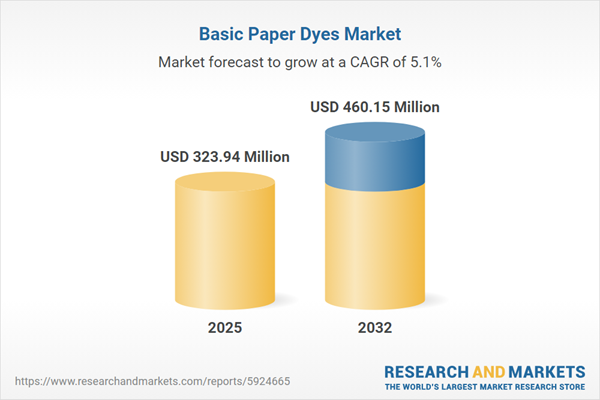Speak directly to the analyst to clarify any post sales queries you may have.
The basic paper dyes market is in a state of transformation, propelled by sustainability mandates, regulatory changes, and the need for robust operations. Decision-makers now require clear, data-backed perspectives on trends shaping supply chains and market strategy across the sector.
Market Snapshot: Basic Paper Dyes Market Overview
The Basic Paper Dyes Market is valued at USD 308.39 million in 2024 and is anticipated to reach USD 460.15 million by 2032, reflecting a compound annual growth rate of 5.12%. This expansion is driven by the increasing emphasis on higher-quality, sustainable paper outputs and the mounting pressure for comprehensive regulatory compliance. Market leaders are strategically realigning portfolios and intensifying research and development efforts to address global policy shifts and rising customer expectations. As companies face operational challenges from new cross-border standards, the ability to swiftly adapt and maintain competitive positioning across both established and emerging markets is becoming essential for ongoing growth.
Scope & Segmentation: Insights for the Basic Paper Dyes Market
- Dye Types: Acid Dyes are chosen for their versatility across various base papers. Basic Dyes ensure consistent and high-quality coloration in complex manufacturing environments. Direct Dyes support flexible production processes. Disperse and Mordant Dyes cater to niche requirements, addressing specialty market needs. Pigment and Reactive Dyes are utilized for their enhanced durability in demanding industrial applications. Sulfur Dyes deliver performance for technically advanced uses.
- Applications: Industrial Paper incorporates advanced dye systems to enhance productivity and quality. Packaging Paper is critical to supply chain resilience and brand differentiation. Printing Paper meets diverse substrate performance needs. Specialty Paper secures sensitive information in official or high-security contexts. Tissue Paper focuses on hygiene and safety standards, especially within food and care sectors. Writing & Printing Paper supports continued demand across education, business, and media channels.
- End User Industries: Hygiene industries target reliable product safety and performance. Industrial production emphasizes repeatability and reliability in outcomes. Labeling ensures traceability and meets regulatory expectations. Packaging sectors require visually robust and functional solutions. Publishing and textiles prioritize color consistency and operational efficiency.
- Regions: The Americas benefit from mature and stable product applications. Europe leads on environmental innovation and compliance initiatives. The Middle East invests in expanded production infrastructure. Africa’s market rises as distribution networks evolve and new industry trends emerge. Asia-Pacific—including China, India, Japan, and ASEAN—shows significant expansion linked to ongoing industrialization and targeted investment across paper sectors.
- Companies Tracked: Key industry players include DyStar Singapore Pte. Ltd., Archroma International GmbH, Clariant AG, Huntsman International LLC, BASF SE, Sumitomo Chemical Co., Sensient Technologies Corporation, CHT Germany GmbH, Kiri Industries Limited, and Atul Ltd., all recognized for advancing sustainability and technological capability within the basic paper dyes market.
Key Takeaways for Senior Leaders
- Recent innovations in dye chemistry are extending the functional lifespan of paper products and helping organizations comply with shifting client requirements and global industry norms.
- Integrating environmentally responsible dyes is critical for aligning procurement and production with sector-wide sustainability objectives and evolving value-chain standards.
- Digital printing technologies are driving demand for specialized dyes, enabling companies to offer more tailored packaging and product solutions to diverse customers.
- Responding effectively to more stringent compliance mandates requires continuous investment in new dye systems and process compatibility across varied operational environments.
- Achieving a strong market position depends on focused R&D initiatives, building value-driven partnerships, and maintaining adherence to internationally recognized quality frameworks.
- Regional approaches vary: European operations lead on regulatory and process efficiency, whereas Asia-Pacific businesses emphasize scaling and operational enhancement to support ongoing market growth.
Tariff Impact: Navigating the US Market in 2025
Shifting US tariff policies impacting dye intermediates have made supplier evaluation and sourcing strategy more critical for market participants. By diversifying supplier bases and optimizing sourcing models, businesses can increase supply chain stability and remain aligned with regulatory changes amid evolving trade dynamics.
Methodology & Data Sources
This analysis draws on specialized industry publications, technical journals, and the latest regulatory updates. It is supplemented by direct contributions from procurement, operations, and compliance leaders, ensuring actionable relevance and alignment with the sector’s current landscape.
Why This Report Matters
- Enables executives to anticipate changing regulatory and supply chain dynamics, reducing operational and compliance risk for international business activity.
- Clarifies innovation trends across regions and highlights strengths of leading markets, supporting informed portfolio decisions and market entry strategy.
- Reinforces process reliability and optimized sourcing to sustain consistent quality and competitiveness in paper dye production.
Conclusion
This report equips leaders with timely insights to adapt strategies, foster operational resilience, and advance sustainable growth in the evolving environment of the basic paper dyes market.
Additional Product Information:
- Purchase of this report includes 1 year online access with quarterly updates.
- This report can be updated on request. Please contact our Customer Experience team using the Ask a Question widget on our website.
Table of Contents
3. Executive Summary
4. Market Overview
7. Cumulative Impact of Artificial Intelligence 2025
Companies Mentioned
The companies profiled in this Basic Paper Dyes market report include:- DyStar Singapore Pte. Ltd.
- Archroma International GmbH
- Clariant AG
- Huntsman International LLC
- BASF SE
- Sumitomo Chemical Co., Ltd.
- Sensient Technologies Corporation
- CHT Germany GmbH
- Kiri Industries Limited
- Atul Ltd
Table Information
| Report Attribute | Details |
|---|---|
| No. of Pages | 180 |
| Published | November 2025 |
| Forecast Period | 2025 - 2032 |
| Estimated Market Value ( USD | $ 323.94 Million |
| Forecasted Market Value ( USD | $ 460.15 Million |
| Compound Annual Growth Rate | 5.1% |
| Regions Covered | Global |
| No. of Companies Mentioned | 11 |









